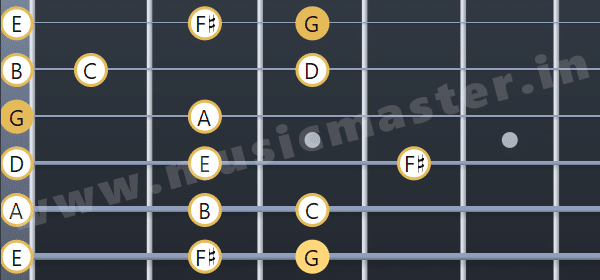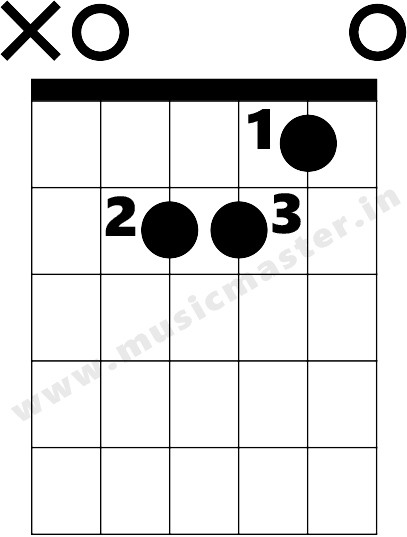The G major scale is quite an easy scale to play on the guitar. The chords in the key of G major are mostly in the open position. So, the it is relatively easier to play. In sheet music written in the G major key, there’s just one accidental next to the treble clef (𝄞). This is called a sharp (#).
Songs in G major scale
Classical composers like Wolfgang Amadeus Mozart, Johann Sebastian Bach and Franz Joseph Haydn predominantly used G Major scale in all of their compositions. The official national anthem of the United Kingdom titled ‘God Save The Queen‘ uses this notes.
This scale was widely used in many pop/rock songs too. Major pop/rock songs like Knockin’ On Heaven’s Door (Bob Dylan), Here I Go Again (Whitesnake), Gravity (John Mayer), You Shook Me All Night Long (AC/DC), Let Her Go (Passenger), Shake It Off (Taylor Swift), and Shallow (Lady Gaga, Bradley Cooper) use the notes of the G Major scale. You can see now why this scale is important to know.
So, without further ado, let’s see how the G major scale on guitar is formulated.
What is a formula for G major scale?
The notes in G major scale guitar uses the major scale formula. This involves the concept of intervals, which can be visualized as the distance between any two frets on the guitar.
Based on the distance between them, the notes are either a tone or a semi-tone away from each other. When the notes have a fret in-between them, the notes are a tone away from each other. When they don’t have any frets between them, they are a semi-tone away from each other.
This is the major scale formula: tone, tone, semi-tone, tone, tone, tone, semi-tone.
By applying the formula above, you can find the seven notes in this scale. Here’s the image below which shows what it looks like on the fret-board from the open 3rd string (the root note) to the 12th fret.

How to play G major scale on guitar?
So, you can start from the root note which happens to be the open 3rd string (G). The next note according to the formula is a tone away. So that is on the 2nd fret. After that, you need to play the 4th fret since this note should also be a tone away according to the formula. The 3rd and 4th notes in the scale are only a semi-tone apart. So, the next note is on the 5th fret (C).
The subsequent notes are a tone apart from each other. So, you can continue to skip one fret in-between to play the 5th, 6th and 7th notes on the 7th, 9th and 11th frets respectively. The final note in the scale should be only a semi-tone away. Therefore, the last note is on the 12th fret, which is the same as the root note (G).
To understand this easier, look at the tabs given below. As a guide, finger numbers are provided (in italics) on top of the notes.
1 – Pointer/index finger
2 – Middle finger
3 – Ring finger
4 – Little finger

How do you memorize G major scale notes on guitar?
Here’s another easy way to remember the notes. The distance between the 3rd and 4th notes and the 7th and 8th notes are shorter i.e., they are only a semi-tone away from each other.
The other notes have a one fret gap between them. So every time you come to the 3rd note and/or the 7th note, remember to play the next fret instead of skipping it. The only note with the accidental (#) in this scale is F. For this scale position, the F# is located on the 11th fret.
The position shown above to play the G major scale guitar is not quite practical since the fretting hand (the hand that holds the guitar strings on the fret-board) needs to constantly change positions to play every two notes on the 3rd string. There are other positions which makes it easier to play this scale.
G major scale guitar positions
The following positions of the G major scale on guitar spans across different strings and reduce the number of frets to play for ease of access. Some of these positions also involve the use of two or more octaves (differences in pitch between the root notes of the scale). Plus, they may not always start from the root note (G).
Open Position

The reason this is called the open position is because the lowest note is the 6th string open (low E). All the notes here are confined to the first four frets of the fret-board. You may have to move the fretting hand down a little bit to press the 4th fret on the 4th string (D).
Check out the tablatures below which provides finger numbers as a guide to understand what fingers of the fretting hand is necessary to play the notes in the first position of the G major scale.

2nd Position

As the name suggests, you need to begin playing the G major scale on your guitar from the 2nd fret. This means that you need to adjust the position of your fretting hand in such a way that you can play the notes on the 2nd, 3rd, 4th and 5th frets using your pointer/index, middle, ring and little fingers respectively. This will minimize movement and facilitate easier playing. Here’s the tablatures with finger numbers for your reference.

3rd Position

The next position for the G major naturally begins on the 3rd fret since that’s where the lowest sounding root note is located (on the 6th string/low E string). The notes here sound similar to the notes in the previous two positions since they are in the same two octaves as the other two scale positions. Interestingly, this scale position has only 3 notes per string.
This is a pattern used frequently in a lot of guitar solos, making this scale position quite easy to get used to. The fretting hand needs to stretch a bit for the little finger to hold down the notes on the seventh fret. Tabs with finger numbers are provided below.

7th Position

The seventh position of this scale contains notes of the scale within just one octave. You need to reposition your fretting hand down to have access to these notes. Just like the second position, for the seventh position, you need to use the pointer/index, middle ring and little fingers to hold down the 7th, 8th, 9th and 10th frets respectively. It’s a lot clearer in the tablatures provided below with finger numbers.

8th Position

The notes in this scale shape are in the same octave of the G major scale guitar from the previous position. This means that the notes between the root note on the 10th fret of the 5th string and the higher-sounding-yet-same-note on the 12th fret on the 3rd string are the same as the ones in the previously discussed position (between the root note at the 10th fret on the 5th string and the 8th fret of the 2nd string).
But, the finger positions differ since the fretting hand needs to move up a fret and the little finger needs to stretch to play the notes at the 12th fret. Check out the tablatures below with italic numbers denoting which finger needs to play which fret correctly.

12th Position

The last of the G major scale positions – the 12th position has one of the F# notes at the 11th fret on the 3rd string. This is the most challenging position of this scale. The highest sounding note is the root note at the highest playable pitch in the standard tuning. This scale position contains two octaves as is visible from the fret-board diagram above.
You need to move the fretting hand near the 12th fret to play these notes. For the notes on the 3rd string, move your fretting hand down by one fret and bring it back to the original position to complete playing the scale. To guide you further, these are the tablatures for this scale position with finger numbers labelled at the top of the score in italics.

So, once you’ve practiced all these scale positions a number of times, try doing them in reverse. Start from the last note on the first string and work your way backwards to the first note of the sixth string. This will help you become more proficient in playing this notes all over the fret-board.
Using the notes of the G major scale, the G major chord is created. Here’s how:
G major chord
Any major chord, including the G major chord guitar is principally made up of 3 notes of their corresponding major scale. This is why chords created this way are also known as triads. To understand how the notes in the G major chord guitar came into being, let’s be reminded of the fundamental seven notes of the G major scale. These are G, A, B, C, D, E, F#, and G again. So, the 1st, 3rd and 5th notes of the major scale are taken to form the major chord triad.
So, for the G major chord guitar , take the 1st, 3rd and 5th notes of the scale i.e., G, B and D. These notes when played by strumming the 4th, 3rd and 2nd strings open by the picking hand together is the G major triad as shown in the chord diagram below.

The chord shown above is not quite complete. Using a combination of these three notes in different octaves across all the strings, this is the G major chord position utilizing the first few frets with open strings.


Relative G major scale chords
The key of G major has seven distinct chords just like the seven notes in the G major scale. One of them is the G major chord. The other chords are often used together with the G major chord in many, many songs. These are the relative chords in the key of G major.

A minor chord
Being one of the easiest chords to play, the A minor chord is also one of the most common and popular minor chords played on the guitar. The notes in the A minor chord consists of the root note (A), the flattened 3rd note (C) and the 5th note (E), played across 5 strings with the root note starting on the 5th string (A).
B minor chord
The fretting hand should be positioned near the 2nd fret. Essentially the first finger ‘barres’ across the 5 strings and the ring, little and middle fingers should hold the shape of the A minor chord while the pointer barres the 2nd fret, holding the root note (B) at the 2nd fret on the 5th string and F# at the 2nd fret on the 1st string.


C major chord
Every beginner’s guitar chord is the C major chord. This is one of the fundamental chords and is quite often used in combination with the G major chord. The ring finger holds the 5th string at the 3rd fret, the middle finger holds the 4th string at the 2nd fret and the pointer/index finger holds the 2nd string at the 1st fret. The 3rd and 1st strings are left open.
D major chord
Yet another easy chord to hold down by the fretting hand, the D major chord is also frequently played along with the G major chord and it is quite easy to shift to from the G major chord shape. Since the D major triad is formed by the 1st, 3rd and 5th notes of its major scale, you need to hold down the 3rd string with your first finger at the 2nd fret, the 2nd string with your ring finger at the 3rd fret and the 1st string with your middle finger at the 2nd fret. The 4th string (D) is left open.


E minor chord
The E minor chord is the relative minor of the G major chord. This minor triad is primarily created using the notes E, B and G. The open position of the E minor chord is the easiest chord to play. Simply press the 5th and 4th strings at the 2nd frets and strum all the strings!
F# diminished
Here’s a chord that most of us may not have heard of – The F# diminished chord. Like all diminished chords, the F# diminished chord is created by taking the 3rd and 5th notes of the F# major scale and bringing it down by a semi-tone. So, the notes in this triad are F#, A and C. Check out this fret-board diagram to play this chord in the easiest way possible.

Conclusion
So, there you have it! Knowing all these chords and scale shapes is sufficient to play or jam along with most pop and/or rock songs that are in the key of G major. Of course, none of the above-mentioned chords or scales can be learned overnight.
Playing any or all of these chord/scale shapes requires meticulous practice. However, try not to get discouraged if you can’t get it right away. Try to think of how you can improve upon your playing, rather than trying to make it perfect.
The best way to progress is to practice with a metronome at a speed you’re comfortable with. Once you’re able to play it right, you may try the same scale shape/chord transitions with a slightly faster tempo.
Want to improve your Guitar playing skills? Learn to play following Guitar Scales.
































